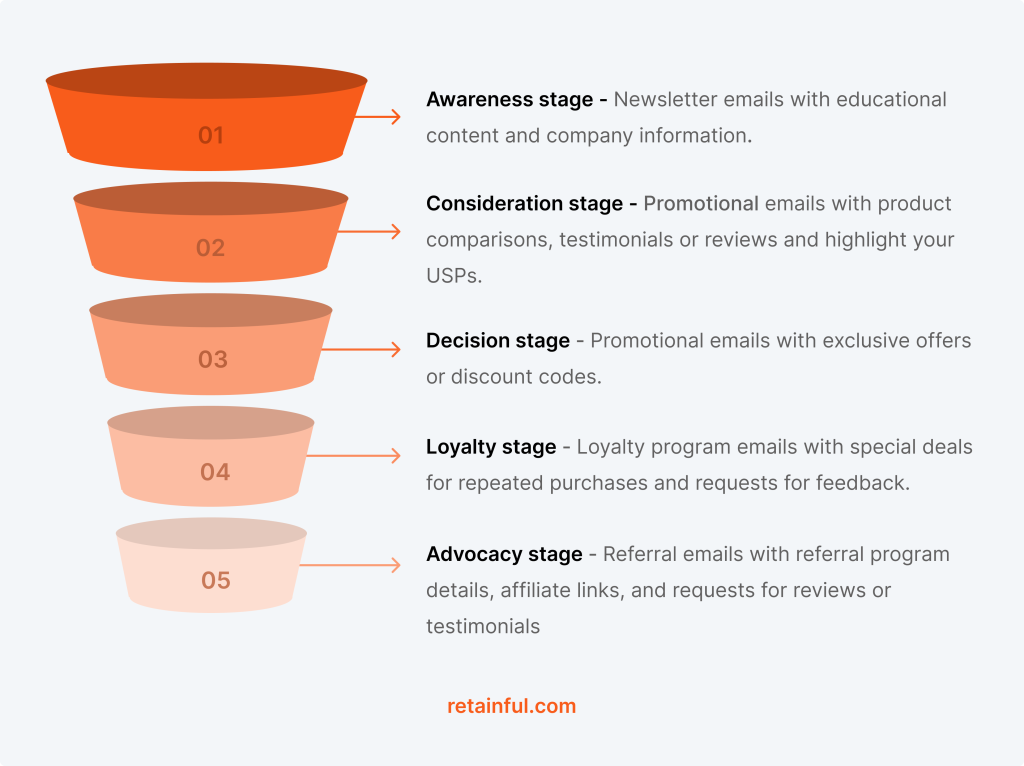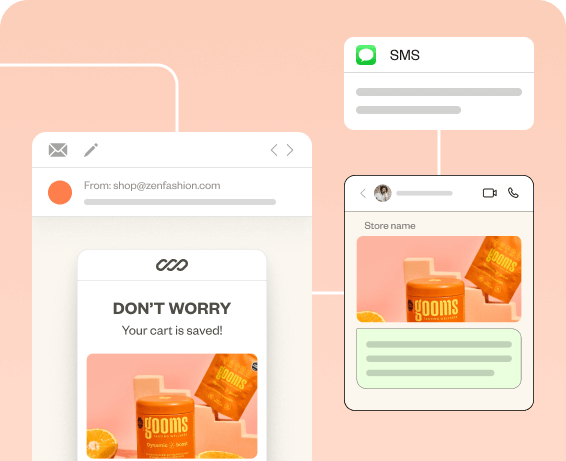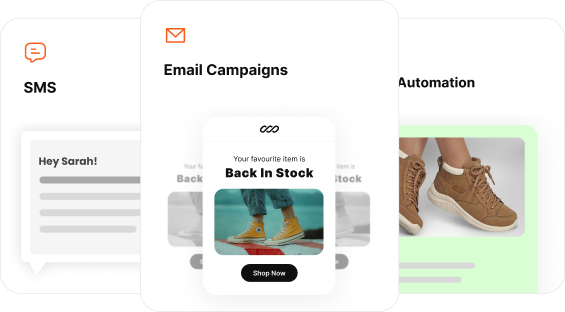Most businesses blast out generic emails and wonder why they’re ignored. It’s because they’re not really talking to anyone in particular.
A well-structured email marketing funnel changes that. It’s like having a thoughtful, ongoing conversation with each customer based on where they stand in their journey with your brand.
The result? Higher engagement, stronger relationships, and more sales – all from emails that feel personally crafted for each recipient.
In this blog, let’s break down what an email marketing funnel is, the stages in it, how to create an email marketing funnel that is high-converting and see the best email marketing funnel examples of how brands implement it.
Let’s dive right in.
Grow your email list with Retainful’s targeted popups and start building your email marketing funnel.
What is an Email Marketing Funnel?
An email marketing funnel is a strategic approach used to guide potential customers through different stages of the buying process using targeted emails.
This includes converting prospects into loyal customers by delivering the right message at the right time based on their level of engagement and interest.
Think of it as a way to talk to people who’ve shown interest in what you do but aren’t quite ready to commit. It’s about nurturing that interest, step by step, turning curiosity into trust and trust into action – all through email marketing.
Here’s how it unfolds.
Email Marketing Funnel Stages
The stages are categorized to capture the nuanced changes in behavior as a prospect moves through different email marketing funnel stages – from initial awareness to becoming a loyal customer.
These stages determine which type of email marketing campaigns to send to a potential customer.

Here are the five email marketing funnel stages.
1. Awareness stage
The first stage is where potential customers first come into contact with your brand.
You introduce yourself. It’s not about hard selling; it’s about making a connection. Your emails here are friendly and informative, offering a clear idea of who you are and what you stand for.
2. Consideration stage
Now they’re listening. You share details about your products, sure, but also why you make them, and how they solve problems. It’s less about features and more about benefits and building a bond.
3. Decision stage
This is the “ask.” You’ve been talking, they’ve been nodding along, and now it’s time to see if they’re in. This email is direct but respectful, with a clear, simple call to action. You’re proposing a next step – the purchase.
4. Loyalty stage
They’ve said yes once, which is great. But relationships are about more than a single yes. These emails are about deepening the connection. Send them tips, insights, or even a first look at a new product. Make them feel part of the club.
5. Advocacy stage
The best customers aren’t just buyers; they’re loyal customers. They tell friends, share your stories, and defend you when you slip up. So, encourage this. Ask them to spread the word, and make it easy for them to do so.
Best Email Marketing Funnel Examples
There are three main email marketing funnel stages: the top (ToFu), the Middle (MoFu), and the Bottom (BoFu).
In email funnel marketing, each stage requires a different approach to ensure your messages resonate with the audience and guide them to the next step.
Here are the best email marketing funnel examples.
1. Top-of-the-funnel email examples
Purpose: Build awareness and educate potential customers.
Type of emails to send in this email marketing funnel stage:
- Welcome emails: These are the first contact with new subscribers.
Welcome emails should introduce your brand, what you stand for, and what subscribers can expect from your emails. It’s about making a good first impression and setting the tone for future communications. - Educational content: Send emails that teach your audience something valuable.
This could be industry insights, tips, tutorials, or general information related to your products or services. For instance, a company selling kitchenware might send recipes or tips for organizing a kitchen. - Newsletters: Regular email newsletters that include a mix of content types, such as blog posts, industry news, upcoming events, or new product teasers. This keeps your brand top of mind without pushing for a sale.
Here is an example email that is targeted at top-of-the-funnel stage customers:

What you can learn from this example?
- Providing the basic information that helps them understand the service or product better.
- Having a non-pushy sales approach
- Providing enough intrigue and information to encourage the recipient to explore further
2. Middle-of-the-funnel email examples
Purpose: Nurture the relationship by providing more product knowledge that aligns with their interests.
Type of emails to send in this stage:
- Case studies and testimonials: Share stories of how other customers have successfully used your product to solve their problems. This builds credibility and helps potential customers visualize the benefits of your offering.
- Deep-dive guides: Send more comprehensive content that delves deeper into topics introduced at the ToFu stage. For example, if the initial content was about the importance of organic ingredients, a MoFu email might provide a detailed guide to starting an organic kitchen.
Here is an example of a middle-of-the-funnel email example:

What you can learn from this example?
- Including informing potential customers about the distinct benefits and the innovative process.
- Including customer reviews in the email to add an element of social proof.
3. Bottom-of-the-funnel email examples
Purpose: Convert leads into customers by making a compelling offer.
Type of emails to send in this email marketing funnel stage:
- Special offers and discounts: Provide exclusive offers or limited-time discounts to encourage leads to make their first purchase.
- Referral Emails: These emails typically target customers who have already made a purchase or are highly engaged with the brand.
- Loyalty Program Emails: Used to deepen relationships with existing customers, encouraging continued engagement and repeat purchases.
Here is an example of a bottom-of-the-funnel email example:

What you can learn from this example?
- Detailing what the customer has earned by being loyal (possibly discounts, exclusive offers, or coupons) addresses the direct benefits of their continued loyalty.
- Create incentives for further purchases
How to Create an Email Marketing Funnel?
Create the best email marketing funnel by following these steps:
- Step 1: Capture leads
- Step 2: Nurture the leads
- Step 3: Convert leads to customers
- Step 4: Do post-purchase engagement
Let’s learn these steps in detail.
Step 1: Capture leads
The first step in the email marketing sales funnel is to capture potential leads and grow your email list. This can be achieved through:
- Lead magnets: Offer valuable resources in exchange for email addresses. These could be discounts, ebooks, white papers, free trials, newsletters, or webinars.
- High-converting landing pages: Design landing pages specifically to capture lead information. Ensure they are optimized for conversions with a clear call to action and minimal distractions.
- Signup forms: Place signup forms strategically across your website, including in the header, footer, blog posts, and as exit-intent popups.
Here is an example of a sign-up form:

Step 2: Nurture the leads
Once you’ve captured leads, the best email marketing funnel strategy is to nurture them into potential customers through targeted and personalized email campaigns.
Here are some lead-nurturing email campaigns:
- Welcome emails: Send a warm welcome email that thanks new subscribers for joining and explains what they can expect from your emails.
- Educational content: Provide valuable content that educates your audience about your industry, products, or services. This builds trust and establishes your expertise.
Step 3: Convert leads to customers
In email funnel marketing, as leads progress through the nurturing phase and show increased engagement, begin focusing on conversion tactics.
You can achieve this in your email marketing conversion funnel through:
- Targeted offers: Based on the lead’s behavior and previous interactions, send personalized offers or discounts that are likely to convert them into paying customers.
- Urgency and scarcity: Utilize tactics like limited-time offers or limited stock notifications to create urgency and encourage leads to act.
- Testimonials and case studies: Provide social proof through testimonials or reviews that demonstrate the value of your products or services.
- Abandoned cart emails: For e-commerce, send cart reminder emails and offer incentives for items left in shopping carts to encourage completion of the purchase.
Step 4: Do post-purchase engagement
This stage of the customer journey is about continuing the relationship after a transaction has been completed, turning one-time buyers into long-term customers.
In email funnel marketing, consistently engaging customers after the sale not only increases retention but also turns them into advocates for your brand, expanding your reach through positive word-of-mouth.
Here are some post-purchase emails you can send:
- Thank you emails: Show appreciation after purchase and offer additional support or resources.
- Cross-sell and upsell: Recommend related products or upgrades that enhance their original purchase.
- Feedback requests: Ask for feedback or conduct surveys to improve your services and keep the communication open.
Tips for Creating a High-Converting Email Marketing Funnel
Implementing these tips will help you optimize an email marketing sales funnel, ultimately leading to better engagement, higher conversion rates, and increased customer retention.
Here are some tips to follow while building an email marketing sales funnel.
- Understand your audience
Before creating an email marketing funnel, gain a deep understanding of your target audience. Research their preferences, pain points, and behaviors. Use surveys, analytics, and customer feedback to create detailed buyer personas.
This email marketing funnel strategy helps you to tailor your funnel to meet the specific needs and desires of your audience. - Segment your email list
Segmentation is crucial for personalizing your emails to fit the needs and behaviors of customers in each stage of the email marketing sales funnel.
You can segment your list based on demographics, past purchase behavior, interaction with previous emails, and more. This allows you to tailor your messaging and offers to increase relevance and effectiveness.
Here is how to create segments for each stage of the email marketing conversion funnel:- Awareness stage: Focus on demographic data, how they found your website (social media, search engines, etc.), and initial interactions with your content.
- Consideration stage: Segment the leads based on the specific content they have interacted with, such as downloading a buying guide or spending time on a product comparison page.
- Decision stage: Look at behaviors indicating purchase intent, like shopping cart abandonment or interactions with your pricing page.
- Loyalty stage: Segment based on purchase history and post-purchase behavior like frequency and average order value.
- Utilize email automation
An email automation software can help you send trigger-based emails (such as welcome emails, cart abandonment emails, and re-engagement emails), which are critical for maintaining engagement and pushing customers through the funnel.
As your subscriber list grows, it becomes increasingly challenging to maintain personalized communication manually. Email automation allows you to scale your email marketing efforts without sacrificing the quality of engagement. - Nurture post-purchase
Post-purchase emails are the key to customer retention.
So, the email marketing funnel strategy is to send thank-you emails, request feedback, and offer after-purchase support. To keep customers engaged, introduce loyalty programs and send regular updates about new products, special offers, or company news.
Capture leads, nurture and retain them with an all-in-one email marketing software – Retainful.
Wrapping up!!
Each email marketing funnel stage serves a distinct purpose, guiding subscribers from initial awareness through to engagement, decision-making, and, ultimately, brand loyalty.
To create a funnel that truly converts, focus on understanding your audience deeply, segmenting them intelligently, and communicating with them at each stage of their journey in a personalized and relevant manner.
By crafting and automating targeted messages tailored to meet the needs and behaviors of users at each phase, you can increase engagement rates and boost conversions.
Read more about email marketing:
- 18 Effective Email Marketing Strategies for 2024
- 11 Email Automation Best Practices to Send Tailored Email Campaigns
Frequently Asked Questions
An email marketing funnel specifically uses email communications to guide potential customers through various stages of engagement and conversion. In contrast, a sales funnel is broader, incorporating all marketing and sales activities across multiple channels to convert leads into customers.
A typical marketing funnel example starts with a broad audience engagement via social media ads (awareness), moves to email newsletters for education (interest), involves webinars for deeper engagement (consideration), and ends with discount offers (conversion).
Identify your target audience, define clear stages of the customer journey, create content tailored to each stage, utilize email marketing automation, and implement tracking tools to measure effectiveness and make adjustments.
A marketing funnel strategy involves planning and implementing steps to guide potential customers from their first interaction with your brand to making a purchase and beyond, optimizing each stage for higher conversion rates.
Companies use a marketing funnel to attract, engage, and convert leads into customers. It helps in organizing marketing efforts, predicting customer behavior, improving sales strategies, and increasing conversion rates.
Increase top-of-funnel marketing by broadening your reach with content marketing, social media campaigns, lead magnets, and sign-up forms to attract more potential customers into your marketing funnel.
The sequence typically follows these stages: Awareness, Interest, Consideration, Intent, Evaluation, and Purchase. Each stage corresponds to different customer mindsets and requires tailored marketing tactics to move users to the next step.


